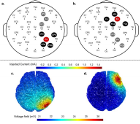Abstract
Attention comprises a wide set of processes such as phasic alertness, orienting, executive control, and the executive (i.e., detecting infrequent targets) and arousal (i.e., sustaining a fast reaction) vigilance components. Importantly, the effects of transcranial direct current stimulation (tDCS) over attentional functioning have been mostly addressed by measuring these processes separately and by delivering offline tDCS with low precision over the stimulation region. In the current study, we examined the effects of online High8 Definition tDCS (HD-tDCS) over the behavioral and electrophysiological functioning of attentional and vigilance components. Participants (N = 92) were randomly assigned to one of three stimulation groups: right dorsolateral prefrontal cortex stimulation, right posterior parietal cortex (PPC) stimulation, and sham. All of them performed – in combination with the HD-tDCS protocol – an attentional networks task (ANTI-Vea) suitable to measure the executive and arousal components of vigilance along with three typical attentional functions: phasic alertness, orienting, and executive control. In addition, EEG was registered at the baseline and at the post-stimulation period. We observed that, regardless the stimulation region, online HD-tDCS: (a) reduced phasic alertness (p = .008), but did not modulated the orienting and executive control functioning; and (b) mitigated the executive vigilance decrement (p = .011), but did not modulated arousal vigilance across time-on-task. Interestingly, only HD-tDCS over PPC reduced considerably the increment of alpha power observed across time-on-task (p = .009). The current study provides further evidence for both an empirical dissociation between vigilance components and the cortical regions underlying attentional processes. We highlight the advantages of using online HD-tDCS to examine the stimulation effects on attentional and vigilance functioning.
